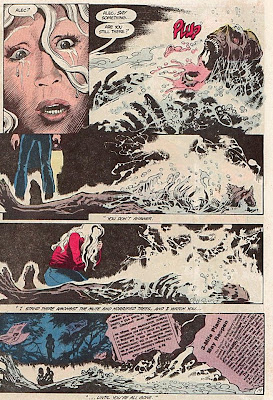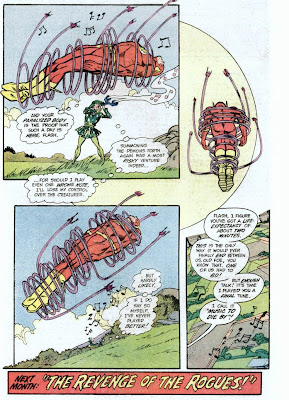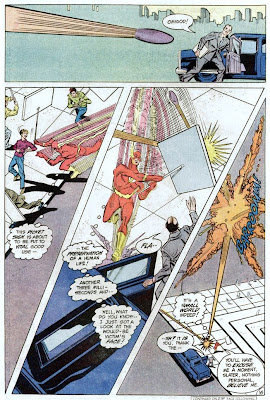Justice League of America 233-236
“Rebirth”
The old Justice League is gone. Long
live the Justice League.
 |
| For better or worse, Vibe is the mascot of the new JLA. |
It's been a while since we
checked in with the Justice League, but as far as stories and membership
is concerned, this is where Post-Crisis continuity really starts.
While it's not officially Post-Crisis yet, the stories from this
point forward do not have the
caveats of continuity discussed
previously. From here on out, what's in the story is what actually
happened. That really shouldn't be too much to ask in the first
place, but if continuity wasn't complicated, there wouldn't be a need
for this blog. Continuity Alerts aside, what did happen to the old
team?
Pre- and
Post-Crisis continuity incongruities not withstanding, what happened
is simple: The JLA became too big and unwieldy for its own good. With
Superman as a reserve member and official membership stretching
upwards of twenty different heroes, the team grew unable to
efficiently handle credible threats. With this in mind, as acting
chairman, Aquaman took it upon himself to both disband the JLA and
then immediately seek to rebuild it as a smaller fighting force
populated with heroes dedicated to the team and able to respond
quickly if called upon.
While Aquaman,
Martian Manhunter, Zatanna and the Elongated Man (along with his
partner-in-crime-and-marriage, Sue) are the only veteran members to
remain on the team, they are joined by a motley crew of new blood.
Vibe is an Hispanic man from the inner-city who, because comics can't
leave any cliché well enough alone, used to run with a gang but has
since reformed his ways a bit. Not only is he a break-dancer (it is
1984, of course) but his powers involve focusing and targeting waves
of seismic force. Vibe's followed by the more straight-laced Steel.
Steel's interesting in that on the surface: he's a legacy hero, son
to the World War II masked avenger Commander Steel, who took the
fight to Hitler back in his day. Steel lives up to his father's
legacy in a different way in that he's actually part machine: most of
his skeleton replaced with steel, his muscles bionics and his flesh
bullet-proof plastics. The kicker is that Steel did not require these
'enhancements' because of an accident or harm done to him: his
grandfather, eager to continue his son's legacy, forced these
surgeries and procedures on his grandson to literally build him as a
hero.
Vixen has a less gruesome and
drama-ridden origin: she's a fashion model who
inherited a mystic relic, 'The Tantu Totem.' Comics can never let go
of alliteration. The Totem gives Vixen the ability to mimic animal
traits: speed of a cheetah, skill of a fox, strength of a gorilla, so
on and so forth. Finally, there's Gypsy, a mysterious girl with the
convenient ability to turn invisible who tags along with the League
but doesn't appear to be a full-time member just yet but she does
have a growing relationship to the Manhunter.
 |
| Aquaman had his moment upstaged by a lame bad guy. Poor Aquaman. |
While the
injection of new blood adds new life to the League, it also brings
with it all sorts of drama-rife interpersonal problems. Steel and
Vibe predictably are often at odds; Zatanna thinks Aquaman is pushing
the new Leaguers too hard and generally being a dick about it;
Elongated Man feels left out of the new team, eager for camaraderie
with the new members that is slow in coming; and Gypsy plain doesn't
trust anyone, opting to remain in the shadows when around the others.
Aquaman may have wanted a team of Leaguers able to dedicate all their
time to the cause, but he was a ways to go before their the fighting
force he envisioned.
In direct contrast
to the old League's base of a satellite in geosynchronous orbit above
the Earth, Aquaman decided that the League needed a more grounded
approach. He took himself literally by basing the team in a warehouse
in Detroit. The team also takes a break, at least temporarily, from
cosmic menaces and alien invaders to take on some local gangs and
other terrestrial menaces such as putting a stop to street gangs in
Detroit and Vixen going rogue from the team to take out a dictator
named Maksai, someone with a connection to Vixen's past, and a claim to the Tantu Totem, that goes
unexplained for now.
 |
| She broke both his damn arms. Pretty sure she doesn't like the dude. |
By the last
chapter of this story, the League faces their first major menace in a
return to cosmic adventure: The Overmaster who kidnaps the team to
his mountain base in Antarctica to decide the fate of the human race.
In the DC Universe, the Antarctic continent is dotted with hidden
alien bases.
The Overmaster is
an alien menace who claims to have been responsible for several
extinction events on Earth going back to the birth of the planet. Who
killed the dinosaurs? This guy. At least that's what he says, like
most comic book villains, Overmasters recruited a band of like-minded
bad dudeds to do his fighting for him. His unnamed team consists of
Black Mass, who can open black holes; Fastball, who throws objects so
fast, they explode on impact; Shirke, a winged woman with a nasty set
of claws; Crowbar, a guy with a crowbar; and Shatterfist, he who
shatters things with his fists.
 |
| Overmaster and his lame-ass team. Just look at Crowbar. The guy with the crowbar, FYI. |
These guys are so
inconsequential, The Monitor, dutifully monitoring the events of the
story, wonders where a being like The Overmaster has such power to
recruit and create new superhumans. He eventually decides that
investigating the matter is not worth his time and moves on to bigger
and better. Not even The Monitor, the
guy who hired out Javelin,
can be bothered with the members of Overmaster's new bad-guy
team. They're all universally lame and aside from Black Mass and
Fastball, I don't think a one of them is seen again after this story.
The next time we see Fastball again, he's killed. Spoiler.
While the two
teams enter into the obligatory battle royale, Aquaman uses his
powers of aqua to deduce that any being, Overmaster or not, who
claims the power he does would not need this band of losers to do his
fighting for him. Stealing away from the fight, the orange-clad hero
discovers that Overmaster may not be who he says he is (a villain
lie?) but instead an alien parasite with delusions of granduer who's
been lying in wait and observing the League, deducing them to be the
greatest assemblage of heroes in way of his dominance of the planet.
When Aquaman jettisons the hidden bases command center, blasting it
into space, Overmaster disappears and take his motley crew of lame
henchmen with him. Another day, another dollar for the JLA and the
first big victory for the neophyte team.
Overmaster is a
disappointment in this story. Every chapter opens with a scene from
pre-history with new forms of life struggling for existence and some
narrator, presumably the Overmaster deciding its not yet time and
extinguishing said life. It's quite a nice build-up but the conflict
and resolution fail to deliver, with the extinction events being lies
told by a boasting alien menace and the conflict being the sort of
rote beat-'em-up comic books are known to peddle. Basically, new JLA
team does not equal new conflicts at all. The Overmaster as presented
here is someone the original team could have wrapped up in much the
same way.
 |
| The League takes on street crime. |
This era for the
JLA team is much maligned by fans, but it's not something I've read
before. I know the character of Vibe is subject to much derision from
comic-book readers. Given this reputation, I can't say the story of
'Rebirth' did much to sway me from this team not being a stain on the
history of the Justice League. Admittedly, stain is a bit harsh;
while the larger conflict and plotline for this particular story was
a failure, I am interested in seeing the various interpersonal
conflicts among the team members play out, specifically if any kind
of resolution occurs regarding the origin of Steel. A legacy
character who has this legacy forced upon him is an interesting twist
in the 'son taking up the fathers mantle' story. This story may be a
muddled failure, but the characters have promise. It will be
interesting to see where everything goes as we approach the Crisis.








































